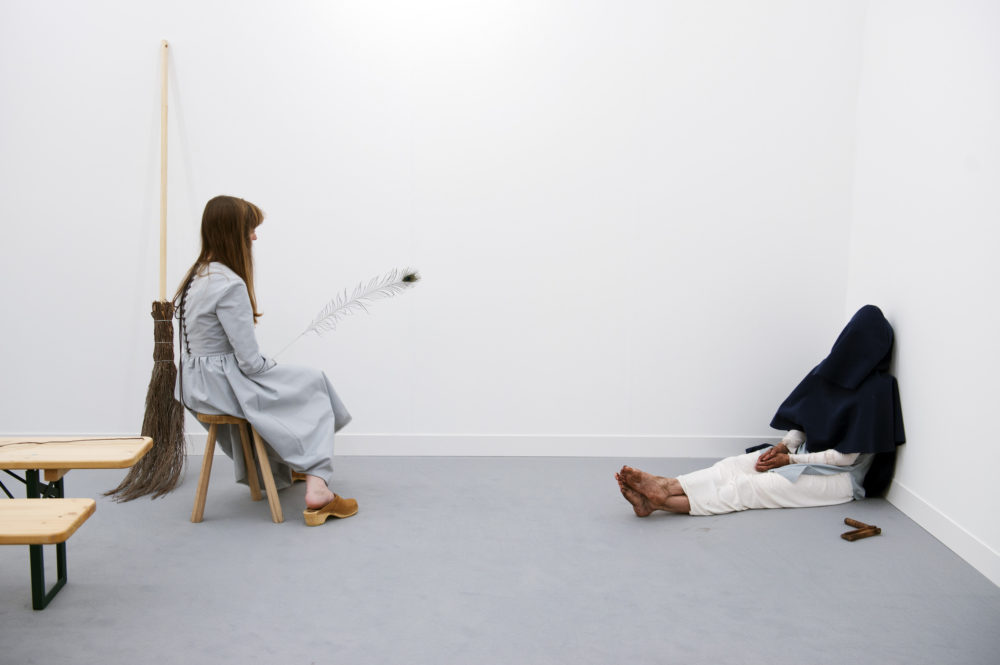
Greatly to the disappointment of people-watchers everywhere, Frieze London this year felt all grown up: less bling, less bad plastic surgery, less trophy footwear. One high-profile collector actually perambulated the fair in rubber flip-flops.
Even the art tended to be less brash, proving that this edition of the fair is low on gimmickry and quick-hit crowd-pleasers—and better for it.
Frieze ran its first Art & Architecture conference on Tuesday, drawing speakers who have profoundly influenced the way we experience art in recent years, from Annabelle Selldorf (a favorite with New York’s gallerists, notably David Zwirner), to Snøhetta (responsible for the new SFMOMA building), and Peter Zumthor, who spoke energetically with LACMA’s Michael Govan about his radical design for the museum.
This preoccupation with the “how” and “where” of art spilled generously over into the fair itself, with a number of booths conceived as Gesamtkunstwerks.
Solo presentation by Francis Upritchard at the Kate MacGarry booth at Frieze London 2016. Photo Lorena Muñoz-Alonso.
Francis Upritchard, who had participated in the conference with her partner Martino Gamper, created a mini “encyclopedic museum” at Kate MacGarry, dressed with dubious specimens drawn from natural history, tribal, and ancient art. Here the authority bestowed by museumlike display legitimized Upritchard’s ersatz anthropo-archeological specimens, while the colorful booth created an appealing foil for her bright modelling paste sculptures.
At Southard Reid, Celia Hempton designed the booth as shards of worn painted wall: a kind of rinsed palazzo with different pigments flushing across the surface. The coloring was picked up in three large-scale portraits, each of which was restricted to the genital area of her male subjects. Other works took on the rough and unfiltered world, including men Hempton had encountered on anonymous video chat sites, and taped atrocities committed by the Islamic State.
Carlos/Ishikawa had their booth transformed into a shoddy Internet café courtesy Lloyd Corporation, complete with peeling ads, as well as functional monitors showing paramilitary recruitment videos and Hillary Clinton’s hacked emails. Lloyd Corporation also sent a marginal workforce around the fair, including a man in a sandwich board handing out random fliers, and a black market handbag vendor.
Lloyd Corporation’s interest in employment insecurity, and forms of life at the edge of the networked, “legitimate” world connects to the theme of the fair’s talks program (commencing Thursday) which explored border territories: public and private, countries, identities, and political ideologies.
Hüseyin Bahri Alptekin’s H-Fact: Hospitality/Hostility (2003–2007) at Rampa prodded at the borderline between exoticism and threat with a series of illuminated signs offering stays at Motel Beirut, Tirana Palace, and Hotel Bagdad. (Recep Tayyip Erdogan came to power in Alptekin’s native Turkey the year the series began.)
Aperto ’93, Massimo De Carlo, The Nineties section, Frieze London 2016. Photograph by Linda Nylind. Courtesy of Linda Nylind/Frieze.
Regionally, it was the galleries from LA that made the strongest showing. The Box carried a suite of political works by Judith Bernstein, Simone Forti and Wally Hedrick. Bernstein’s works, three of which were drawn from 1966-67, mocked the machismo of hawkish US foreign policy, and included an assemblage made from a flag and a limp balloon with wizened, scrotal, pouches. Hedrick’s powerful anti-heroics lead him to cover his existing works in black paint each time the US launched an invasion: a series that he’s returned to for every war from Vietnam to Iraq.
At LA’s Various Small Fires, Liz Magic Laser’s Primal Speech engaged with more recent political issues. The booth is conceived as a primal therapy suite, complete with padded walls and screaming jars. In a video, a life coach invites “participants” to share their feelings about Brexit and the rise of Donald Trump, and their own sensations of anger and impotence. That it is hard to tell which answer responds to a political question and which to an emotional one suggests how deeply political affiliation is driven by emotional forces. As a work it connects interestingly to James Bridle’s Cloud Index, a recent digital commission for Serpentine Gallery, which suggests links between voting patterns and the weather in the UK.
A suite of booths is this year dedicated to key gallery exhibitions of the 1990s. Among them, Richard Billingham’s astonishing photo series Ray’s a Laugh (published in 1996), has lost none of its impact, either in portraying a squalid, troubled domestic existence with deeply felt and nuanced affection, or in its use of domestic light and composition.
There’s currently not much evident at Frieze drawing on a view of the world close to that Billingham offered from within a tower block in Cradley Heath outside Birmingham. Is it down to depleted social mobility in the UK? Or would the Billingham of today have escaped into a screen and carried out a parallel existence online rather than forcing himself to really look at his own parents, and the spiral of debt and dependency that was consuming them?
Dominique Gonzalez-Foerster R.W. F. (1993), Esther Schipper, Nineties section at Frieze London 2016.
Other emerging talents of the 1990s—notably Wolfgang Tillmans and Dominique Gonzalez-Foerster—have now been enfolded into the mainstream. A major retrospective of Tillmans’s work opens at Tate in February, and his silvery white north-European light, and fascination with subcultural aesthetics have been drawn on in recent decades, most recently in Gosha Rubchinskiy’s studies of post-Soviet youth culture.
This is Frieze Magazine’s 25th anniversary year, and the enduring impact of the generation of artists that appeared in that decade is as much a tribute to the new generation of publications that flourished in the 1990s (which include Purple, i-D and Dazed & Confused as well as Frieze itself) and the emergence of a new type of art museum (of the type that would welcome and accommodate the space-filling, physically and intellectually accessible works of, say, Gonzalez-Foerster) as it is to the artists themselves.